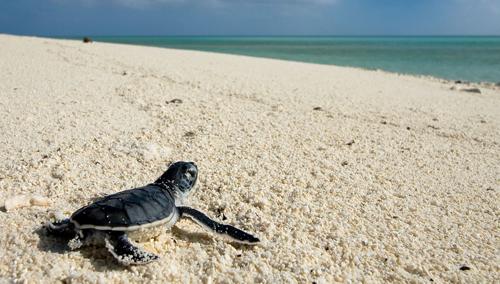You don’t need to be an ocean kind of guy like me to enjoy
Jacques Perrin and Jacques Cluzaud’s amazing new film “Oceans,” but
it raises the awe factor quite a bit if some of your best memories
were on a beach or in salt water.
The two Jacques are the same team who brought us the astounding
2001 Oscar-winning documentary “Winged Migration,” and it’s
distributed by the Disney Company under a new moniker,
“Disneynature.” I suggest you see “Oceans” in the biggest, best
movie theater you can find. Being inches away from a 110-ton Blue
Whale as it gracefully swims by with its baby, is much more
impressive when the largest animal to ever inhabit our planet is
life-sized.
It was Walt Disney himself who turned the studio’s first nature
documentary, “Seal Island,” into a story about a cute and lovable
baby seal by telling the director faced with miles of similar
footage of Canadian and Alaskan pinnipeds: “No one will notice if
you use different seals…they all look alike.” They don’t use that
kind of trickery in “Oceans” because this one doesn’t tell an
anthropomorphized story. And unlike “Winged Migrations,” where the
flights of dozens of different bird species were held together by
the over-arcing narrative of an annual migration, “Oceans” is
episodic.
What this means is that we get little snippets of absolutely
awesome footage of dozens of different animals from dozens of
different regions of the world. The script, written by the
filmmakers and narrated by Pierce Brosnan in an odd, throaty,
voice, occasionally lets us know where we are and what kinds of
creatures we are watching, but most of the time it doesn’t bother
to tell us.
It doesn’t matter. There are scenes in here that are almost too
incredible to believe that they weren’t created by the animators
who made “Avatar.” My favorite is an astounding sequence filmed
off the coast of South Africa over a seven-month period. Like the
starlings that spiral over our local vineyards, tens of thousands
of sardines school in undulating waves while dozens of dolphins
circle around the pulsating masses, and then dive through them to
feed. Meanwhile, in the sky above this liquid vortex, hundreds of
frigate birds dive headfirst to grab their share of fish. Then the
camera pulls back to capture the entire scene, and a humpback whale
bursts upwards in the exact middle of the maelstrom.
You’ve truly got to see it to believe it.
And then there are the migrating crabs in Sydney harbor.
Hundreds scuttle sideways across the sea floor in the same
direction only to come across another wave of crabs headed into the
opposite direction. What happens when the two waves of crustaceans
meet is astounding and once again the camera pulls back to show the
bigger picture—miles and miles of crabs as far as the eye can see.
And did I tell you about the marine iguanas or the whales sleeping
head down or the swordfish using their swords, or the walrus mother
cuddling her baby, or….
This is a film everyone can see and appreciate, for although
sharks do consume seals and birds eat newly hatched sea turtles,
they do so in a bloodless, “G” rated way. Also, there are very
subtle reminders that the great diversity and abundance of the deep
is being squandered by a combination of human greed and
indifference. The most effective scene is one of seine nets in the
Mediterranean Sea where divers swim with the catch as it is being
pulled to the factory ship. We watch protected fish, dolphins and
sea turtles trapped and drowning in the netting while yellow-booted
feet are all we need to see of the fishermen still using a type of
net which many nations —but not all—have made illegal.
Comments? E-mail gi*********@*****st.net.









